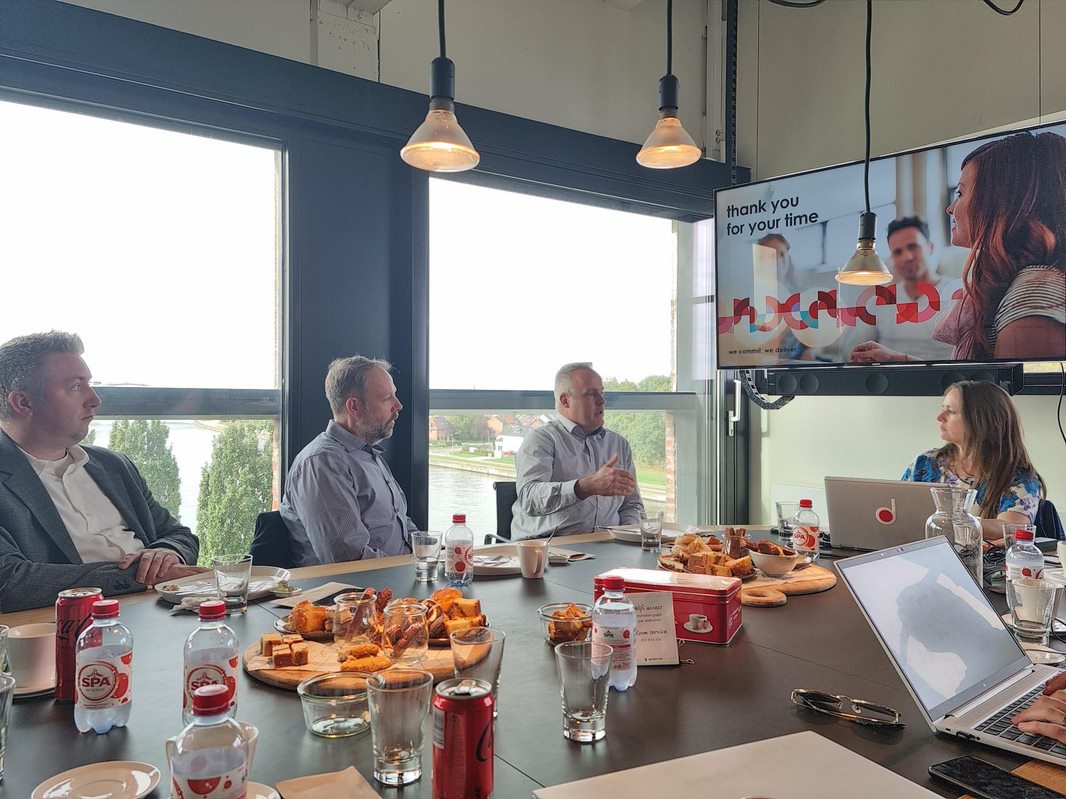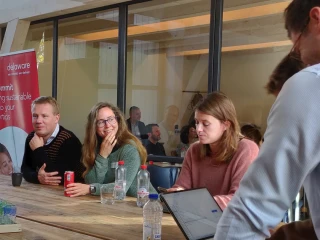Manufacturing workers not digitally skilled? Think again!
Let’s be realistic: the assumption that frontline workers aren’t digitally skilled is a thing of the past. “Despite the availability of easy-to-use tools, frontline workers often resort to personal devices and apps, such as WhatsApp, due to a lack of workplace resources or knowledge,” explains Thalia. “This exclusion from digital transformation affects their employee experience, which is unfortunate. Organizations that empower their frontline workforce with modern digital office tools and/or devices gain significant business advantages through increased efficiency and streamlined workflows.”.

Our key-findings to start your frontline workers experience
1. Build a multidisciplinary team to define the digital workplace transformation vision
To build an engaging digital workplace for manufacturing frontline workers, it's important to identify their true workplace needs by immersing yourself in the field. “For our customers, this isn’t as easy as it may seem at first sight,” acknowledges Frank. “Often, IT, HR, Communications and Operations departments do not even speak the same language, or there is simply not enough time, budget or commitment to learn more on the frontline working context.”
“What’s more, we see that mostly IT is in the driver’s seat of this workplace innovation. They enter an idea, create a business case and ask for management support to execute it. But, this approach often only leads to symptom relief instead of continuous improvements supported by a digital transformation vision. To go beyond this, our customers consider introducing the role of a Business Process Owner (BPO). Their role is to network within the organization, think cross-functional and be the link between IT, frontline workers and business departments like HR and Communications to align and engage all relevant stakeholders to drive the desired business results,” Thalia adds. “It’s an idea that we fully support.”
2. Think big, act small and meaningful
Let’s say you have determined your vision and created a roadmap. How do you translate this into reality? “Our guests agreed quite quickly that breaking down the employee experience journey into manageable, smaller projects was is the way to go. This way, IT can further demonstrate the value of new tools or devices to business and management,” Frank clarifies. “We see that most of our customers like to experiment and use focus groups to give feedback, to truly understand the ‘What’s in it for me – and for us’, or even grow an ambassador network to get the necessary buy-in for future phases or extended digital workplace roll-outs. To sum up, always keep your roadmap or vision in mind, but use the roadmap’s quick-win projects to kick-start your journey.”
3. A governance discussion is key
“At delaware, we believe that the investment to provide company tablets or smartphones pays off. Even more, we challenge our customers to build a relationship of trust and allow people to take up ownership of how they want to use their new (digital) tools,” states Thalia. “It’s about finding that balance between trust and the necessary IT governance in terms of security and company agreements.”
4. Investing in user adoption delivers greater return on investment
“User adoption activities must be an intrinsic part of any frontline workers’ digitalization project,” says Thalia. “It’s important to actively engage your frontline workers in your digitalization process. Don’t just ‘drop’ the tool, but inform them concretely and frequently about the what, why and how it will simplify their job during training sessions. Finally, be patient and listen to their feedback. This way, you embed the change and move the organizational culture forward for future employee experience initiatives.”
5. Data-driven decision making can enhance the employee experience roadmap
As the future of work for frontline workers changes swiftly, HR and IT departments need to work closely together to drive positive change and create people-centric workplaces. “Apart from tools, other themes such as well-being, feedback or sense of belonging are an important part of the employee experience,” Frank elaborates. “To create such a sustainable workplace, we advise our customers to use workplace analytics to better understand their employees’ needs. Additionally, people data set out a better negotiation position towards management when asking for support or resources to further build the desired employee experience roadmap and continuously revisit it with the data that is collected on a day-to-day basis.”
Conclusion: the time is now. Let’s start your frontline workers experience!
To stay competitive, manufacturing companies must bridge the gap between frontline and office workers. To do so, both IT and business need to team up to find the right balance between technology and people. Digitalization in manufacturing isn’t just about adding tools. It's about making sure people remain at the heart of this incremental change process, by ensuring smooth communication flows, operational efficiency, and safety and comfort at work. Together with a pragmatic project and change management approach, creating a positive employee experience journey can lead to long-term success.
Interested to know more? Or looking for more inspiration or a sparring partner? Frank & Thalia are here to support you in your frontline workers employee experience challenges! Get in touch or download our e-book to empower your frontline workforce.
/Manufacturing-media_circle_square-1080x1080-(1).webp?mode=autocrop&w=320&h=320&attachmenthistoryguid=40f5eea6-c747-4df0-96d3-53955938b359&v=&c=a32ca90106b2a8eeb95d7785c29ca8a43a202c7b4f2a7f0ad2827ffd46b0b647)



